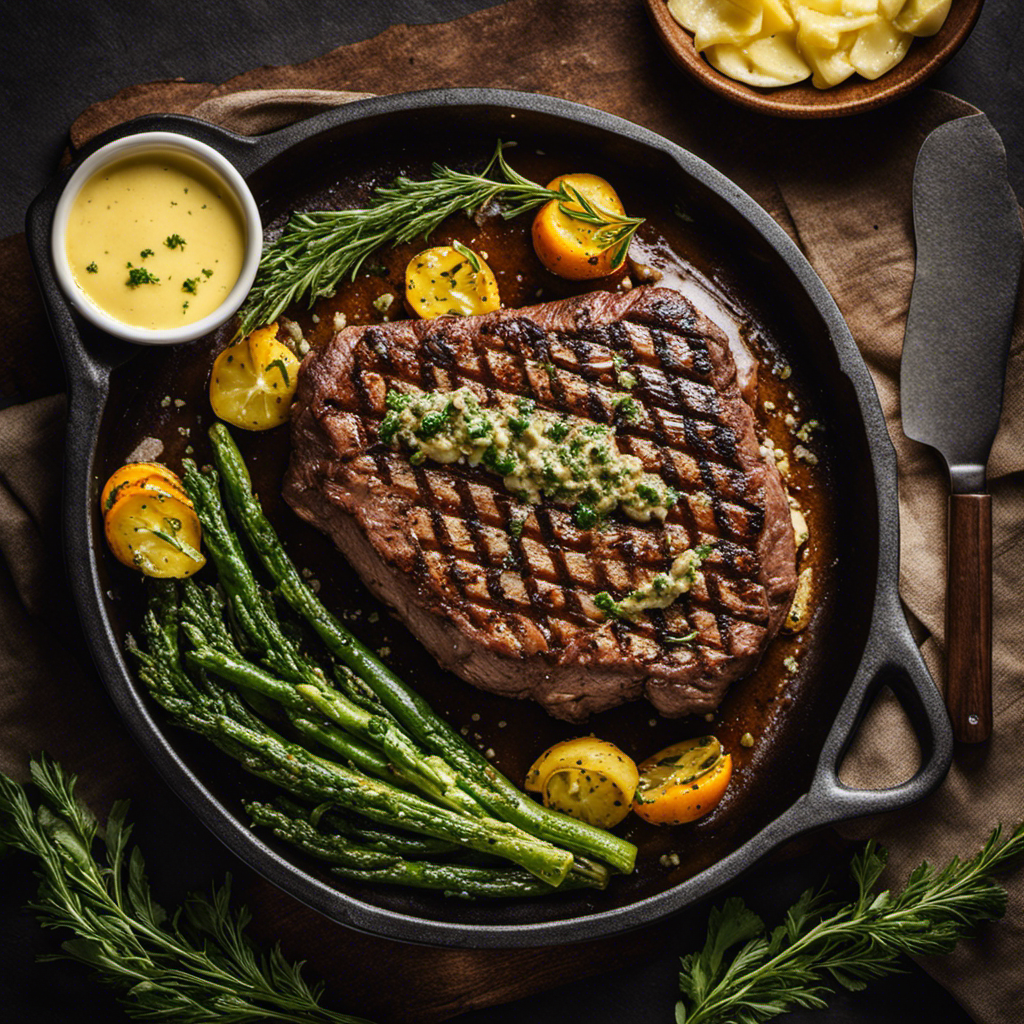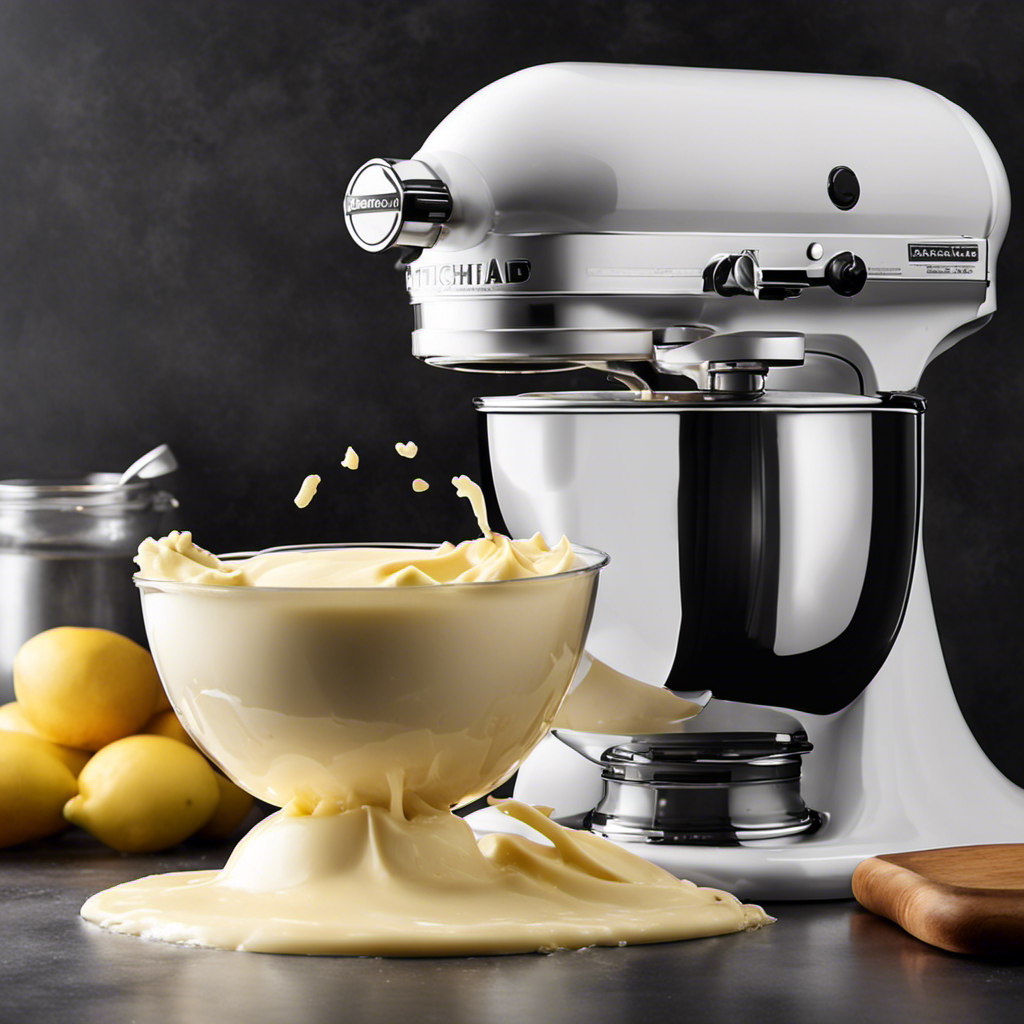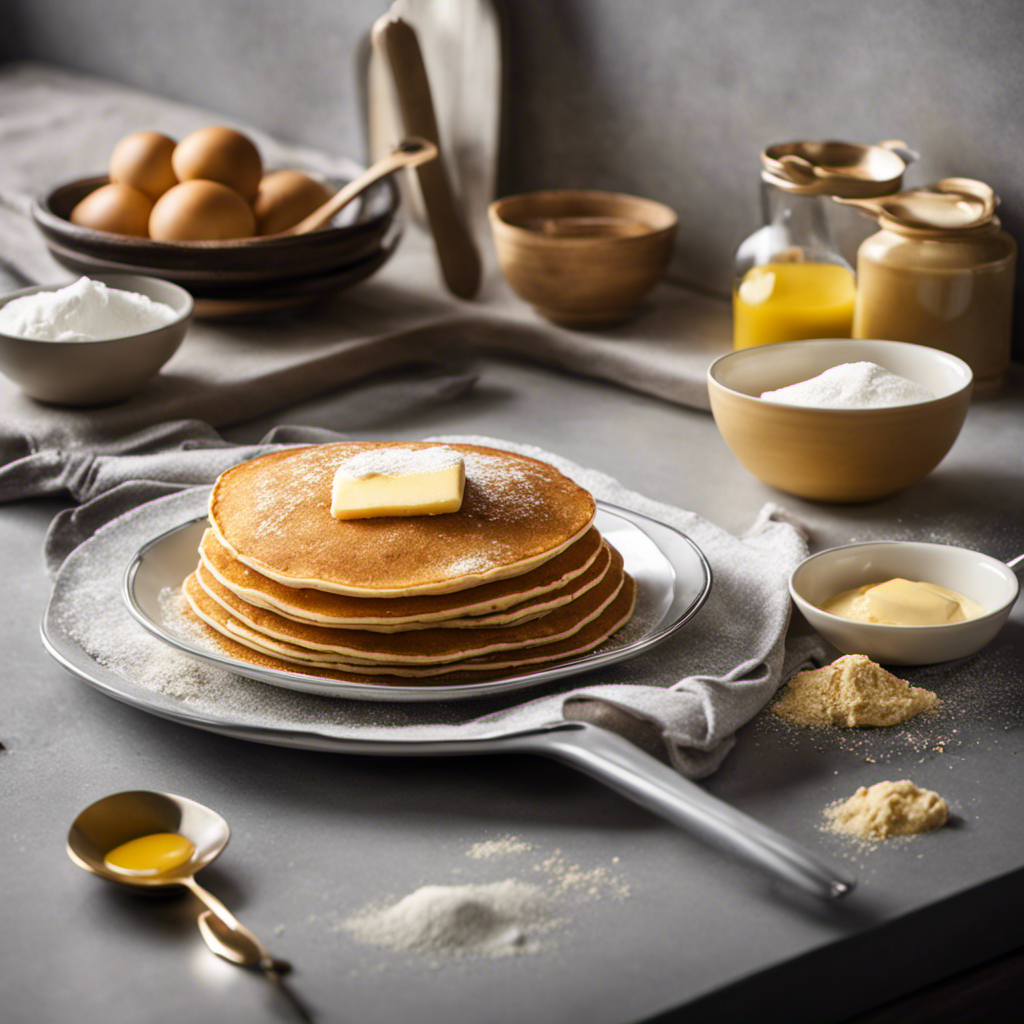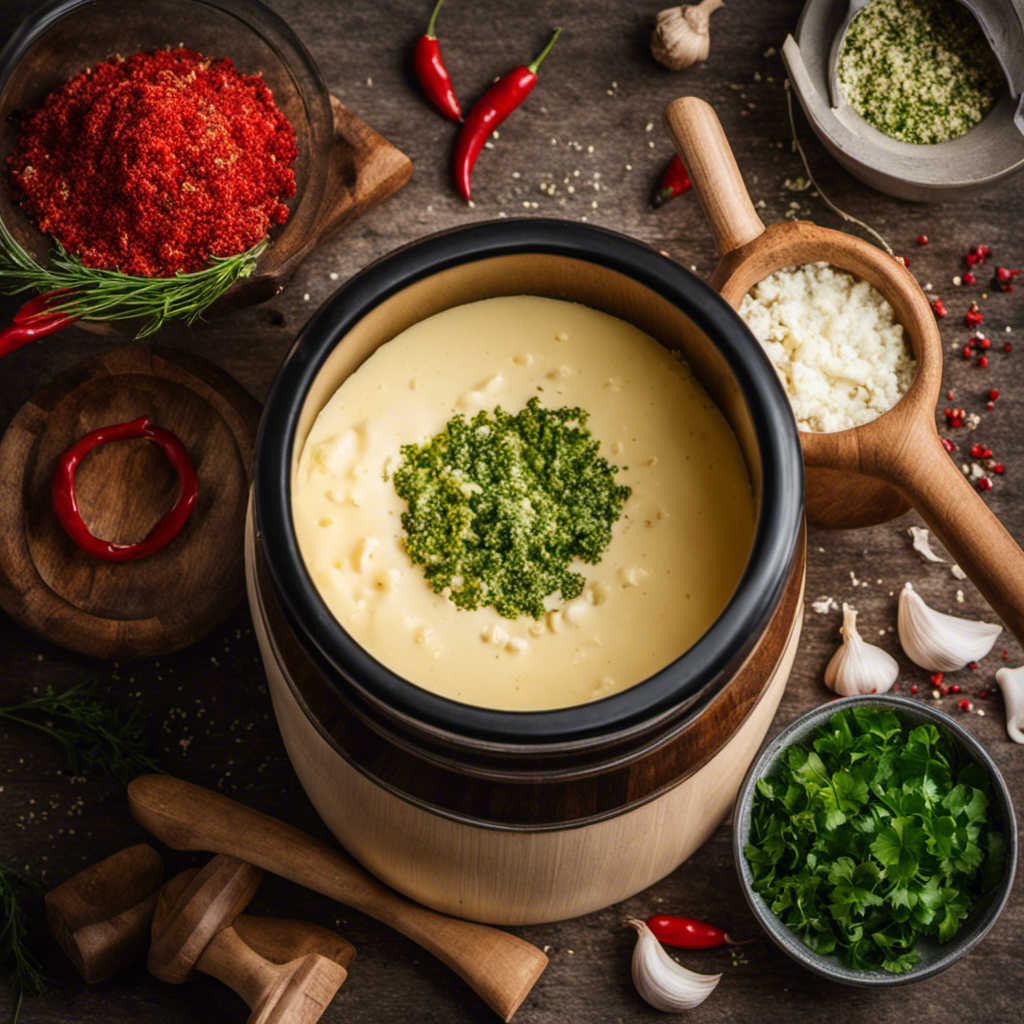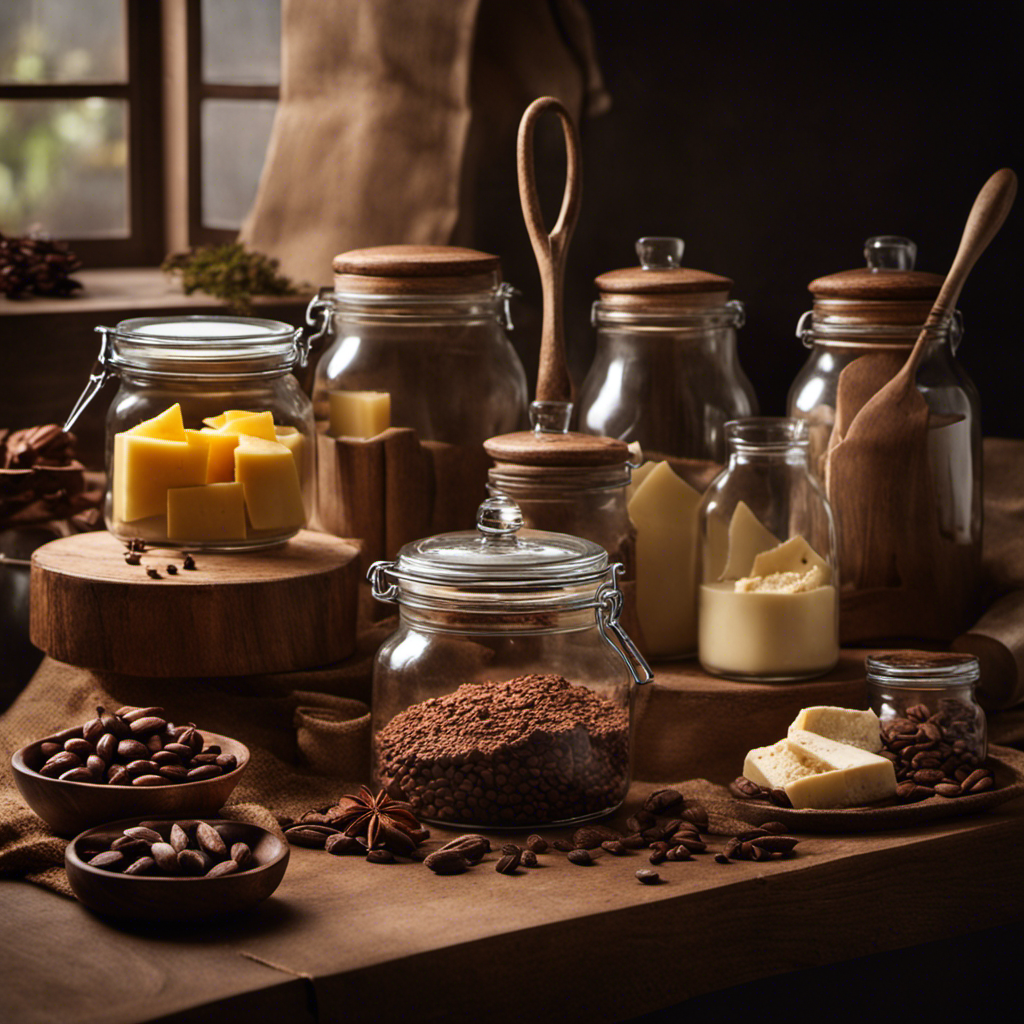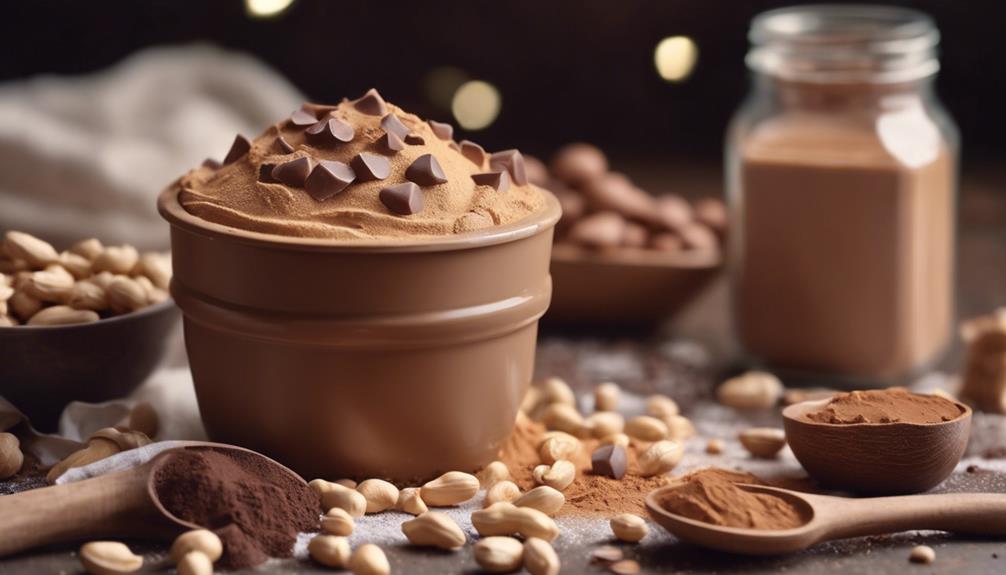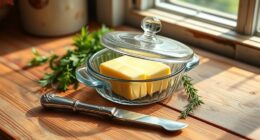I have always enjoyed a well-cooked steak, but I couldn’t shake the feeling that it was lacking something. That’s when I stumbled upon the key to elevating my steak game: homemade butter.
In this article, I’ll share with you my tried and true method for making the most delicious butter to accompany your steak. From selecting the right butter to infusing flavors and cooking techniques, I’ll guide you through the process step by step.
Get ready to elevate your steak game with this mouthwatering butter recipe.
Key Takeaways
- Choose high-quality, unsalted butter with a creamy texture for the best results in making butter for steak.
- Infuse flavors into the butter by experimenting with alternative fats, fresh herbs, and spices to enhance the richness and complement the natural flavors of the steak.
- Chill and shape the butter into a log shape using plastic wrap before using it, as it helps maintain the butter’s shape and consistency.
- Store butter properly in an airtight container in the refrigerator or freeze it using a vacuum sealer for longer-term storage, ensuring its freshness and quality.
Selecting the Right Butter
When selecting the right butter for your steak, make sure to choose a high-quality butter that is unsalted and has a rich, creamy texture. This is crucial as it will enhance the flavor and add a luxurious touch to your steak.
While there are flavored butter options available, I recommend sticking to plain unsalted butter to allow the natural flavors of the steak to shine through. However, if you’re feeling adventurous, you can experiment with different flavored butter options like garlic, herb, or even truffle butter.
If you prefer butter alternatives, ghee or clarified butter can be excellent choices as well. These options provide a unique taste profile while still offering the richness and creaminess that butter brings.
Now that you have chosen the perfect butter, let’s move on to preparing the butter mixture.
Preparing the Butter Mixture
First, you should start by combining the softened butter, minced garlic, and chopped herbs in a bowl. This step is crucial in creating a flavorful butter mixture that will elevate the taste of your steak. When choosing ingredients, opt for high-quality butter with a rich and creamy texture. It’s important to use softened butter, as it will blend more easily with the other ingredients.
Next, add in minced garlic for a subtle yet savory flavor. Chopped herbs like rosemary, thyme, or parsley can also be included to enhance the overall taste. Once all the ingredients are combined, mix them well until they are evenly distributed throughout the butter. This butter mixture will not only add a burst of flavor to your steak but also help to keep it juicy and tender.
Now, let’s move on to the next step of infusing flavors into the butter.
Infusing Flavors Into the Butter
To enhance the taste of your steak, you’ll want to infuse flavors into the butter mixture. This can be done by using alternative fats and adding herbs and spices.
When it comes to using alternative fats, you can experiment with different options like olive oil, coconut oil, or even bacon fat. These fats can add a unique flavor profile to your butter, complementing the richness of the steak.
To add herbs and spices, you can finely chop fresh herbs like rosemary, thyme, or parsley, and mix them into the butter. Additionally, you can incorporate spices like garlic powder, paprika, or black pepper for an extra kick.
The combination of alternative fats, herbs, and spices will create a flavorful butter that will elevate the taste of your steak.
Now that you have infused the flavors, it’s time to move on to the next step of chilling and shaping the butter.
Chilling and Shaping the Butter
Once the flavors have been infused, it’s important to chill and shape the butter mixture. This step is crucial in ensuring that the butter maintains its shape and consistency when used to enhance the flavor of the steak.
Here are some key techniques and tips to follow during the chilling and shaping process:
- Place the infused butter mixture onto a sheet of plastic wrap.
- Use the plastic wrap to tightly roll the butter into a log shape.
- Twist the ends of the plastic wrap to secure the butter log.
- Refrigerate the butter for at least 2 hours to allow it to firm up.
By chilling the butter, it becomes easier to handle and shape. Additionally, the chilling time allows the flavors to further meld together, resulting in a more flavorful and well-balanced butter.
The shaping technique using plastic wrap ensures that the butter maintains its desired form and can be easily sliced or melted onto the steak when ready to serve.
Seasoning the Steak
When seasoning your steak, remember to generously sprinkle salt and pepper on both sides. This step is crucial to enhance the flavor of the meat and create a mouthwatering crust.
However, there are other marinating techniques and alternative seasonings that can take your steak to the next level.
One marinating technique is to use a mixture of soy sauce, garlic, and ginger. This combination adds a savory and slightly sweet flavor to the steak, while also tenderizing the meat.
Another alternative seasoning is a blend of smoked paprika, cumin, and chili powder. This creates a smoky and slightly spicy profile that pairs well with grilled steak.
Experimenting with different marinades and seasonings can elevate the taste of your steak and impress your guests with bold and delicious flavors.
Cooking the Steak With Butter
While cooking, basting the steak with melted butter adds richness and enhances the tenderness of the meat. It’s a cooking technique that I highly recommend for anyone looking to elevate their steak game. Not only does the butter infuse the meat with a deliciously buttery flavor, but it also helps to create a beautiful crust on the outside.
If you’re looking to explore alternative fats, there are a few options that work just as well. Here are some alternatives to consider:
- Ghee: Clarified butter with a nutty flavor and higher smoke point.
- Olive oil: Adds a fruity flavor and works well for medium-rare to medium steaks.
- Avocado oil: A healthy option with a high smoke point and mild flavor.
- Bacon fat: Imparts a smoky, savory taste that pairs perfectly with beef.
Serving and Storing the Butter
When it comes to serving butter, the temperature plays a crucial role in enhancing its flavor and spreadability. It is recommended to serve butter at room temperature, around 68 to 70 degrees Fahrenheit, to achieve the perfect consistency.
On the other hand, if you need to store butter for a longer period of time, it is important to keep it in an airtight container in the refrigerator, where it can last for several weeks.
Butter Temperature for Serving
To achieve the perfect consistency, it’s important to let the butter come to room temperature before serving it with the steak. This allows the butter to soften and become spreadable, enhancing the dining experience.
Here are some key points to consider:
-
Butter melting point: Butter has a melting point of around 90°F (32°C). Allowing it to come to room temperature ensures that it melts easily when placed on a hot steak.
-
Butter temperature for cooking: When cooking with butter, it is recommended to use it at a slightly higher temperature, around 140°F (60°C). This helps to achieve a nice sear and enhances the flavor of the steak.
-
Softening the butter: To bring the butter to room temperature, simply leave it out on the counter for about 30-60 minutes before serving. Avoid using the microwave, as it can melt the butter unevenly.
-
Spreading the butter: Once the butter is at room temperature, use a butter knife or spreader to evenly distribute it over the cooked steak. This allows the flavors to meld together and adds a rich, velvety finish to each bite.
By following these guidelines, you can ensure that your butter is perfectly softened and ready to enhance the flavor of your steak.
Now, let’s move on to the next section about long-term butter storage.
Long-Term Butter Storage
If you want to keep your butter fresh for an extended period of time, storing it in an airtight container in the refrigerator is the best option. However, if you’re looking for a longer-term storage solution, vacuum sealing and freezing the butter can be a great choice. Vacuum sealing removes all the air from the package, preventing any oxidation and keeping the butter from spoiling. When freezing butter, it’s important to wrap it tightly in plastic wrap or place it in a freezer bag to protect it from freezer burn. By following these steps, you can ensure that your butter stays fresh and ready to use whenever you need it.
| Pros | Cons | Tips |
|---|---|---|
| Extends shelf life | Requires vacuum sealer | Use small portions for individual servings |
| Prevents oxidation | Extra step in storage process | Thaw in the refrigerator before using to maintain texture and flavor |
| Protects butter from freezer burn | Takes up freezer space | Label and date the packages for easy identification and rotation |
| Convenient for long-term storage | May alter texture of butter | Use within 6 months for best quality |
| Allows for portion control |
Frequently Asked Questions
How Do I Know Which Type of Butter Is Best for Making Butter for Steak?
When it comes to making butter for steak, it’s important to know which type is best. Different types of butter can enhance the flavor in different ways. Real butter, in particular, offers a rich and creamy taste that complements the steak beautifully.
Can I Use Margarine or a Butter Substitute Instead of Real Butter?
I wouldn’t recommend using margarine or a butter substitute instead of real butter for making butter for steak. Real butter adds a rich flavor and enhances the taste of the steak. It’s worth using the real deal for the best results.
What Are Some Different Flavors or Seasonings I Can Add to the Butter Mixture?
There are countless ways to enhance the flavors of a butter mixture. Different spices, herbs, and seasonings can be added to create unique tastes. Additionally, the flavored butter can be used creatively in other dishes.
How Long Should I Chill the Butter Mixture Before Shaping It?
I chill the butter mixture for about 2 hours before shaping it. This allows it to firm up and hold its shape better. It’s like sculpting with clay, but tastier.
Can I Use the Leftover Butter for Anything Else Besides Serving With Steak?
Yes, you can definitely use the leftover butter for other dishes besides serving with steak. There are many alternative uses for flavored butter, such as spreading it on bread, melting it over vegetables, or using it to cook eggs.
Conclusion
So there you have it, a step-by-step guide on how to make butter for steak.
By selecting the right butter, infusing flavors, and cooking your steak with butter, you can take your steak to a whole new level of deliciousness.
Whether you prefer a classic garlic herb butter or something more adventurous like a spicy sriracha butter, the possibilities are endless.
So go ahead and try making your own butter for steak, and elevate your next steak dinner to a whole new level of flavor.
Your taste buds will thank you.
